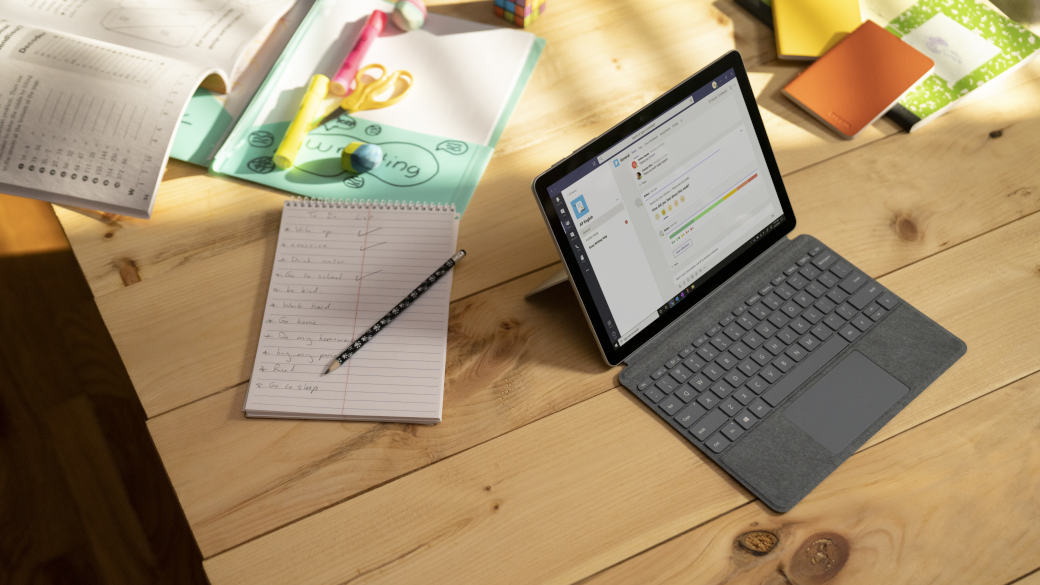For many schools around the world, the shift to remote learning has understandably been an enormous transition with serious challenges along the way. However, for O’Dea High School, a Catholic school in Seattle, the transition has been relatively seamless. A look at the systems and programs the school put in place, and how administrators, educators, and students are adapting, may offer short and long-term solutions for others.
O’Dea is in its third year of using technology to enhance learning through a 1:1 device-to-student ratio (students use Microsoft Surface devices), digital textbooks, and the use of innovative tech tools that help personalize student learning.
“This is not what we were preparing for,” David Olinger, the school’s director of strategy, said of the global pandemic that has shuttered schools worldwide. Nevertheless, he said the school was ready to transition to remote learning once the crisis hit the Seattle area. “It felt almost like with a little bit of a nudge in the right direction, we just kind of flipped a switch,” he said of the change.
To ensure educators and staff felt supported, David provided extra training in the days just before the transition, such as making sure teachers knew how to take attendance virtually, could see that students had their cameras on, were creating interactive and engaging lessons, and understood the norms and expectations that would make remote learning a success. And he’s available to help them now, as needed.
Rory McNulty, a Spanish teacher at O’Dea, who also helps lead the school’s social and emotional learning efforts, says one thing that eased the transition was that the school already used Microsoft Teams, a digital hub for communication and collaboration, extensively. “We didn’t have to start from scratch,” said Rory.
Flexibility and creativity are essential
Teachers are working hard to foster community and rich conversations, even from afar. David says teachers are being creative, asking students to participate in collaborative activities like Socratic Seminars, in which students practice their speaking and listening skills, over Teams.
“The game’s changed,” David says. “We don’t know when we’re going to go back to school, and our teachers want to really provide a great experience to the students.”
David also is helping teachers think through assessment strategies. Rory, for example, is using performance tasks, like the group dialogue project mentioned above. And teachers are using tools like Flipgrid, the video sharing platform, and Forms, a tool for assessing learning and getting feedback.
Tech tools that support students
All teachers post their assignments in Teams, giving students a single access point for assignements and classroom collaboration. Teachers also use Microsoft Stream to record lessons in case a student misses class or wants to watch a lesson back later.
And while students obviously miss seeing and working closely with their friends, there are many ways students can collaborate in Teams. Rory says she set up private channels in Teams, including for a project in which the students had to work together and write dialogue in Spanish.
“They sometimes meet in separate channels in small groups. I will pop in and check in on those even while the larger group might be meeting in a separate channel. The students are always on task,” explains Rory.
Maintaining accountability
Rory says she likes the way OneNote Class Notebook, which has a personal workspace for each student, a content library for handouts, and a collaboration space for lessons and activities, is embedded in Teams. She says that has been particularly helpful during distance learning. “The students know I’m going to be going through their notebooks as they’re working. There are lots of ways to keep them accountable and on task.”
Teachers at O’Dea take attendance by looking at the list of those appearing in a Teams meeting. If a student is missing, the teacher can call their device or cell phone and bring them back in. If they don’t respond, they get marked absent. The school also requires that students leave their cameras on throughout a lesson. And since teachers use Stream to record lessons, they also can go back and check to see whether students were present.
Keeping it simple for your IT team
David says from the perspective of an IT administrator, Microsoft Teams is a great asset.
“From the IT side, I love that it manages itself. I set it up every year with School Data Sync (SDS). To support our registrar, if students need to change classes, all their Teams and everything will be switched (easily) thanks to SDS.”
School Data Sync is a free Microsoft tool that reads rosters from your school information system (SIS) and creates classes and groups for Teams, Intune for Education, and third-party applications.
Supporting each other
David is getting a lot of calls from educators around the country asking for advice on moving to distance learning. He says having a unified platform is important. “Having a student learn five different remote learning tools makes it so that they can’t access things easily, and it also makes it administratively difficult,” he says.
David says one thing he likes about Microsoft Teams is it is continuously improving based on educator and student feedback. “There’s a real sense of support, that Microsoft is really listening to the users, to the teachers,” he says. “And they’re listening to the students, and they’re making changes in real time.”
OneNote Class Notebook has also been indispensable, as have the Surface devices, which offer a strong digital inking experience, David says. “We chose a device that had the best digital inking experience for students,” he added. “You have to annotate in learning.”
Rory adds that the investments in technology and training at O’Dea are paying off. While she says there are aspects of school-based teaching she misses, such as routinely pairing two kids up to work side-by-side, she’s grateful she’s able to deliver so much instruction effectively through remote learning.
Learn more about how to get started using Microsoft Teams to keep the learning going for your students during these challenging times.
And to make it make it easy to connect with each other and answer your questions, we’ve set up a remote learning community. Sign up to join this group and share ideas and get help today.



.jpg)
.jpg)